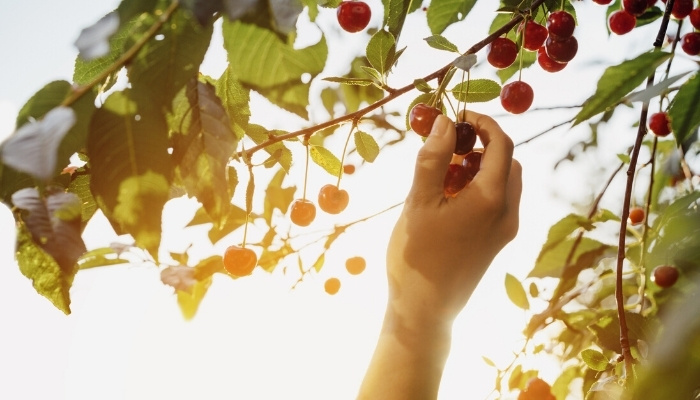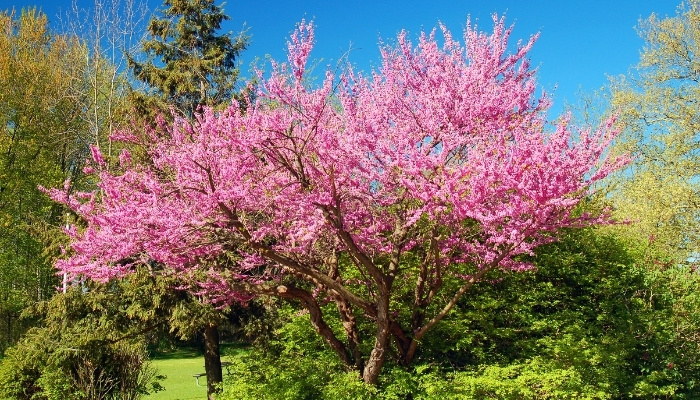Cherry trees make a charming and enjoyable addition to any garden due to their beautiful blossoms and scrumptious cherries. Have you ever pondered the time required for cherry trees to mature and produce fruits?
How long do cherry trees take to grow? Cherry trees are some of the fastest-growing fruit trees. They average 1 to 2 feet a year depending on the variety. The trees should start bearing fruits two years after planting. Within 4 to 5 years, the trees are mature and will bear full crops.
A lot of factors negatively impact or improve the growth rate of cherry trees. These include the weather, watering, and fertilization. Read more to find out about the growth rate of cherry trees.
Cherry Tree Growth Rate – What To Know
Few fruit trees match the growth rate of the cherry tree. The tree doesn’t waste time to start flowering and fruiting after only 2 years. Even before the tree has reached maturity and developed a robust root system and a full canopy, you can start harvesting cherries.
Average Time Cherry Trees Take To Grow
On average, cherry trees planted as saplings take between 4 and 5 years to reach maturity. By that time, you can expect to harvest a full crop every year. However, some varieties have faster growth rates than others.
How Long Do Cherry Trees Take To Grow From Seed?
If you choose to grow your cherry tree from seed, then you’ll have to be very patient. The tree will take anywhere from 7 to 10 years to bear fruits. Maturity happens a few years later.
How Long Does It Take Potted Cherry Trees To Grow?
Potted cherry trees, or dwarf cherries, often start bearing fruits within the first 2 years after transplanting.
How Long Do Cherry Trees Take To Produce Fruit?
Cherry trees take 2 to 3 years to produce fruits. You’ll likely get full crops after 4 to 5 years.
When To Harvest Cherry Tree Fruit
Cherry trees are late bloomers, but the fruits ripen quickly, allowing you to start harvesting the cherries from mid-April until late July.

Factors That Affect Cherry Tree Growth Rate
The growing conditions around the cherry tree affect its growth rate. That and the variety of cherry trees you chose can be decisive factors in how fast the tree will mature and start bearing fruits. Here are some of those factors.
1. Soil
Sweet cherry trees prefer soft, loamy, and well-draining soil. The soil has to be rich in nutrients to accommodate the fast growth rate of the cherries.
Sour cherries are not as demanding. They usually grow in any type of soil, even poor soil. Amend clayish soil with perlite or coarse sand to loosen its texture and improve drainage.
2. Water
Watering is one of the crucial factors that affect the growth rate of the cherry tree. In the first year, the young tree needs the soil to be constantly moist but not wet.
Regular irrigation is required since the root system is still underdeveloped and the tree relies on the water coming from above the surface, but once it establishes, the tree doesn’t require as much watering.
3. Light
The cherry tree thrives under the full sun. It needs between 6 and 8 hours of direct sunlight every day during the spring and summer. Dim light or partial shade will impact the growth of the tree.
A total lack of direct sunlight will stunt its growth and diminish the chances of flowering and bearing fruits. Potted cherries need to be near a window facing the west or south.
4. Temperature
Cherry trees prefer cool and dry weather. High humidity and temperatures interfere with the tree’s growth. The tree also needs chill hours during the cold winter in order to flower and bear fruits in the spring. In general, cherries have a high tolerance for frost and frigid winters.
5. Fertilization
Even if the soil is fertile, cherry trees need regular, albeit light, fertilization to improve their growth rate and flowering.
Choose a fertilizer like this one that is low in nitrogen but high in phosphorus. Organic compost and homemade fertilizers are ideal substitutes for chemical fertilizers.
6. Pruning
Pruning is not just an ornamental task when it comes to cherry trees. It’s an essential part of the tree’s growth and ability to flower.
The best time to prune the cherry tree is when the tree is dormant in the winter. Cut off any damaged, broken, or intertwined branches. This will trigger new growth in the spring and increase the cherry crop.
7. Wildlife
Wildlife damage can impact the growth and full development of the cherry tree. The tree is most susceptible to wildlife attacks during the first year.
Deer and rabbits can inflict serious damage to the tree that might not be easy to recover from. Protect the young tree with chicken wire cages until its canopy grows beyond the reach of wildlife.
Average Height & Spread of a Mature Cherry Tree
Cherry trees are medium-sized trees that average about 35 feet tall at maturity. Their canopy spreads between 12 and 14 feet across when fully grown. If desired, both size and shape can be controlled with careful pruning.

Average Lifespan of a Cherry Tree
The average cherry tree will live between 15 to 30 years depending on the variety. Some varieties, like black cherry trees, could live up to 250 years. Some cherry trees in Japan are 2,000 years old and still flowering.
Fastest Growing Cherry Tree Varieties
Not all cherry tree varieties grow at the same rate. Some reach maturity within a couple of years while others take a little longer to develop a full canopy and root system. Here are the fastest-growing cherry tree varieties.
- Yoshino: This variety grows about 3 feet per year. At maturity, it reaches 35 feet tall easily. The canopy has an umbrella shape, and the flowers are pink. Suitable for Zones 5 to 8.
- Pink Star: Averages between 2 to 3 feet a year but only grows to about 25 feet tall. It blooms in the spring and is hardy to Zones 5 to 8.
- Benton Cherry: Grows about 2 feet a year and averages 14 feet tall and wide at maturity. The tree is also hardy for Zones 5 to 8.
Related Questions:
Are Two Cherry Trees Required To Produce Fruit?
Cherry trees are not self-pollinating. That means you have to plant at least two cherries in the garden within 50 feet of each other to enhance pollination.
Make sure the two cherries are of different varieties and that they’re compatible. Not all cherry varieties are suitable for cross-pollination.
How Can You Germinate Cherry Seeds Fast?
On average, cherry pits take up to 90 days to germinate. However, you can speed up the germination by placing the pits in a Ziploc bag along with moist peat moss and keeping them in the fridge for 6 to 8 weeks. The seeds will germinate within 30 days after you plant them.
Conclusion
Cherry tree growth rate is affected by different factors including temperature, humidity, light, and the type of soil.
You can improve the growth of the tree by feeding it with organic compost and keeping the soil damp throughout the first year of its life. Protect the young tree against wildlife to avoid serious damage.
